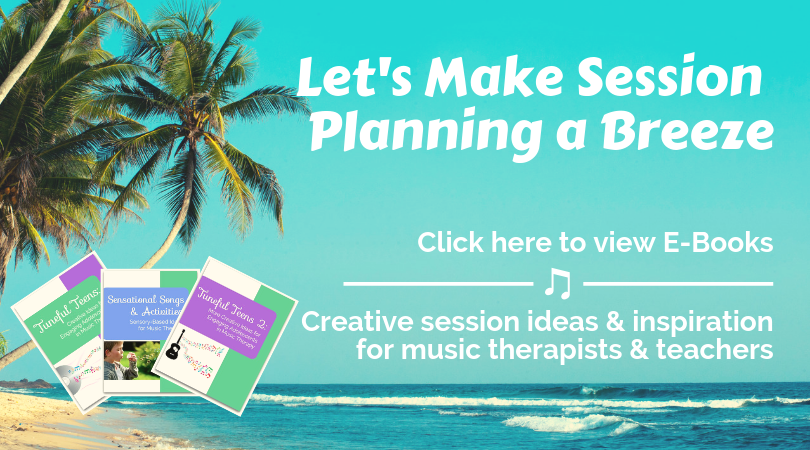Sometimes I wish I was an octopus.
There are times when I am going into a session carrying my guitar, a keyboard, a gathering drum, AND a bag of instruments….and eight arms would really be helpful!
(Who needs the gym when you have sessions all day long, right?)
I have found that there is one instrument in my bag of tricks that is worth it’s weight (literally!) in gold. It’s one of the most versatile instruments in my bag and it can be used with children with many different levels of functioning.
That instrument is…
…the Q-chord!
I love the Q-chord because I can use it in so many different ways with my clients. Here are just a few of the ways…
1) Use the Q-chord for a hands-free (or almost hands-free!) accompaniment
I will often set one of the styles (March or Country) and use it to provide a rhythmic beat for marching or jumping activities. Once the beat is set, it’s completely hands-free so you can model movements and provide hand-over-hand assistance.
I can also set a style and use the chord pad to change chords. Even when I do this, I still have one hand free to model movements with a scarf, streamer, or maraca.
2) Use the Q-chord for clients with limited range of motion in their arms
I love using this with my classes of children with severe and profound intellectual disability and Cerebral Palsy or those clients who have limited range of motion in their arms. With a small movement, the clients can reach out a finger or hand on the touch pad and make a beautiful sound.
There are so many ways to vary the style, chord progression, tempo, and even instrumentation on the touch pad that it never gets boring! If the child moves their finger or hand up and down the touch pad, they are receiving a good amount of sensory stimulation.
3) Use the Q-chord to allow your client to accompany themselves
This is perfect for a child, tween, or teen. I choose one of the client’s favorite songs and make a song sheet. (For example, in a session last week, it was the song “You’ve Got a Friend” from Toy Story – who doesn’t love that song?!)
I make up a song sheet that has the lyrics of the song and with the chords over top (I make the chords large and bold so they stand out). Then we choose a style on the Q-chord and the client begins playing the song by pressing the chord on the keypad that matches the chord on the song sheet. After that goes smoothly a few times, we trying singing along at the same time. Talk about working on divided attention!! You can make this activity as simple or as challenging as you want, depending on the level and needs of your client.
4) Use the Q-chord for improvisation
Sometimes I will simply set the Q-chord in front of a child, tween, or teen, and just let them explore. There have been times they’ve discovered things even I didn’t know the instrument could do! After they explore, we move into an improvisation – they are allowed to choose the chord progression, the instrumentation on the touch pad, the tempo, etc, etc, etc.
5) Use the Q-chord to facilitate social interaction
I have a dyad sessions where two siblings are working on social skills such as waiting your turn, asking for a turn, reflecting what the other is doing, and working together. The Q-chord is perfect for this! I have one “control” the chords on the keypad while the other chooses the instrumentation and strums the touch pad. They must work together to make a song! I also have them reflect back what they heard the other sibling do (“How was your sister strumming? Was it fast or slow?”) Then we switch and they have “control” over the other side of the Q-chord.
Now do you see why I say this is the most versatile instrument in my bag? I absolutely love it.
I want to hear from you…yes YOU! Leave a comment below and let me know one creative way that you use the Q-chord in your session with children, tweens, or teens.
I’d love to get some fresh ideas!



I own the precursor to the Q chord – the Omnichord. Thanks for the encouragement to break it out again.
Greetings! Am from the Philippines and we don’t have the Q-Chord over here. Around how much does it cost and where can it be bought?
I am a musician working with special children and a Q-chord might help a lot. Thanks for your great ideas!
Hi! Westmusic.com is where I get ALL my instruments – check it out!
I can TOTALLY relate about the feeling to be an octopus! I have a QChord too. They are awesome! Great suggestions.
I’m glad you can relate!!
I also use my Q-chord quite a bit. It is awesome for doing movement where I want to be up and moving too. I feel the guitar can be a barrier at times but the Q-chord is smaller and much easier to march with! I also like to use it as a reinforcer with specific clients who especially love the Q-chord. Once we have completed our other activities then they are allowed to play the coolest instrument ever!